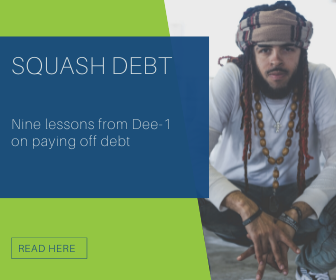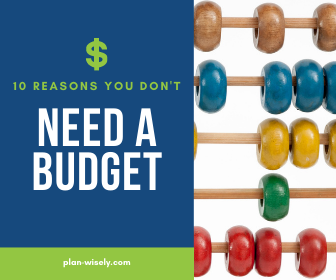How to Pay Off Debt

Paying off Debt? Start Here.
Part of prudently managing debt is making sure you have a plan to repay what you borrow. Any plan starts with a solid grasp of your budget and a full emergency fund! While it may seem counterproductive to start with saving before paying down debt, let’s discuss why these two planks make the best foundation.
Start with a budget.
It’s not enough to track expenses. That’s not a budget, that’s a list. A good budget provides insight into your household’s relationship with money! Specifically, the money you work so hard to earn.
As for debt repayment, use your budget to identify areas where you can create additional cash savings. That way, you can make payments above the minimums as often as possible. Any extra payments help reduce the repayment period, which cuts down on the cumulative interest.
Use your budget to identify your monthly expense figure. That number is important because it will serve as the foundation for your emergency fund.
Build your emergency fund.
An emergency fund is, as the name implies, a savings account you use when you need cash unexpectedly. Your monthly expense number is the starting point. You want to have three months of your monthly expense figure in cash. If you spend $10,000 per month, you need $30,000 in the emergency fund. Having an emergency fund can hedge against having to go into more debt in the event of an emergency. It allows you to be prepared for the unexpected and avoid an emergency setting you off track financially.
 You may be wondering how using a budget and having an emergency fund helps you pay down debt. Using your budget and emergency fund to springboard past debt repayment and into building up wealth allows you to maximize your financial situation and prepare for the future! Imagine adding $1,000 a month to your retirement account or your child’s college fund instead of paying back your lender. Or borrowing money for a vacation only to use the cash you accumulated ahead of time to immediately pay it off!
You may be wondering how using a budget and having an emergency fund helps you pay down debt. Using your budget and emergency fund to springboard past debt repayment and into building up wealth allows you to maximize your financial situation and prepare for the future! Imagine adding $1,000 a month to your retirement account or your child’s college fund instead of paying back your lender. Or borrowing money for a vacation only to use the cash you accumulated ahead of time to immediately pay it off!
If you’re struggling to make progress on your emergency fund or just can’t quite get your budget to work, please schedule some time with our office. We’re here to help!
2 Proven Methods to Pay Off Debt
We all know the feeling; it can hang over our heads like a storm cloud. But remember, debt is a part of a total financial picture, so it just comes down to learning to manage it well and work to pay it off in a way that makes sense for your financial goals.
It’s common for households to have more than one type of debt and it’s important to know those types of debt because they can play a key part in a debt payoff strategy. There are two broad categories for debt: secured and unsecured. Secured debt is backed by collateral such as your home or car and usually comes along with a lower interest rate. Unsecured debt is much riskier (and expensive) because it’s not secured by collateral, this would include credit cards, personal loans, and student loans.
As you’re thinking about how to pay off your current debt, you may be wondering how to prioritize? The two most debt prioritization strategies are the snowball method and the avalanche method. Here’s an overview of each:
Snowball method.
The snowball method prioritizes paying off the lowest balances first. There’s a positive psychological boost to be had by zeroing out a debt account, which can then be used as a springboard to tackle the next chunk of debt. It’s not financially preferable if you have a lot of high-interest debt, but it can be a good approach if you have small amounts of debt with several lenders.
Avalanche method.
This approach prioritizes the highest interest rate first, regardless of the balance. The goal is to minimize the amount of interest you must pay while you work to retire the debt. That’s because interest paid is money that doesn’t reduce how much you owe; it just goes into the company’s pocket that lent you the money. The avalanche method is the mathematically optimal way to pay off debt but may not be right for everyone.
Paying off debt starts with a firm grasp of your spending and savings habits. If you’ve already accumulated a high amount of debt, you don’t want to add to the pile! Once that’s done, paying off debt is a matter of staying motivated!
If you’re needing help creating a debt payoff plan, don’t hesitate to email me. Together we can look through your entire financial picture and determine the best place to start to reach your short and long-term financial goals.

Tackling Student Loans
For many households, student loan debt can be the biggest monthly expense (after their mortgage) and it takes forever to pay off. Degrees of all kinds can come with a hefty price tag of tens of thousands of dollars. If you or someone you know has over large amounts or lingering student loan debt, there are some ways to retire it! Here are three options:
Refinance the student loans.
This option may be suitable if the loan carries a high interest rate (7% or greater), have high monthly payments or wish to combine multiple loans. Refinancing consolidates those loans into one new loan with a single payment. You’ll have to consider the size of your monthly payment amount versus the length of your loan; taking longer to repay the loan means a lower monthly payment, but that also means paying more in interest over the life of the loan.
Check eligibility for an income-driven repayment (‘IDR’) plan.
This strategy is best if most of your loans are federal and your loan balance is high relative to your income. The plan restructures your debt based on your income, family size, state, and the type of federal loan you have. The IDR reduces your monthly payment amount based on these factors.
There are four IDR plans to choose from. In general, they each call for a monthly payment between 10% and 20% of your discretionary income. To learn more about IDRs, visit this information page from StudentAid.gov.
If eligible, seek student loan forgiveness.
If you work full-time in the government or any public service job, you may be eligible for Public Service Loan Forgiveness (‘PSLF’). If you’ve made 120 consecutive monthly payments (10 years), you may be eligible to have the remaining balance of your loan forgiven. Importantly, your loans must be federal; private loans aren’t eligible for the PSLF program. For more information about the PSLF program, visit this information page from StudentAid.gov.
Student loans can equal a lot of money but eliminating that level of debt is doable! For some inspiration, here’s a link to just one story: she paid off $100k in loans making less than $50,000 per year in New York City. Not exactly the cheapest ZIP code in the US!
There are a few ins and outs to consider when considering a payoff plan for large student loans (or any type of debt) so please call me today so we can determine the best course for you. Contact our office today to schedule some time. We’re here to help!


